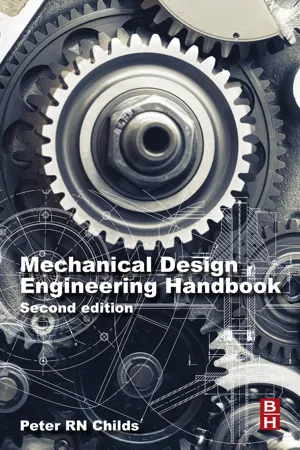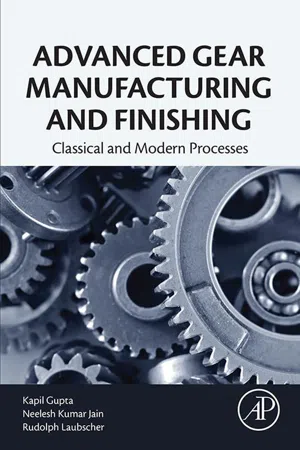Epicyclic Gear
An epicyclic gear, also known as planetary gear, is a gear system consisting of one or more outer gears, called planet gears, revolving around a central gear, known as the sun gear. This arrangement allows for compact and efficient speed and torque transmission, commonly used in automotive transmissions, bicycles, and industrial machinery.
4 Key excerpts on "Epicyclic Gear"
- eBook - ePub
- M J Nunney(Author)
- 2007(Publication Date)
- Routledge(Publisher)
...However, a point of further interest is that in the early 1980s the British company of Self-Changing Gears Ltd introduced a fully automatic five-speed transmission system for European and American city buses, which is based on the original Wilson gearbox but is provided with electro-hydraulic control. Epicyclic Gearing has by no means been confined to use in gearboxes. Among the other applications of this type of gearing that may be found in motor vehicles are overdrive units for passenger cars and light commercial vehicles; two-speed final drives and hub reduction gears for heavy-vehicle rear axles; and torque-dividing differentials in the transfer gearing of four-wheel-drive vehicles (Sections 18, 20 and 21). Advantages of Epicyclic Gearing The principal advantages of an epicyclic over a layshaft gear train may be summarized as follows: 1 Changes from one ratio to another can be effected without interruption of the drive, because the permanently meshed gear train is engaged by friction elements. 2 It can be made more compact for a given torque capacity, because its members rotate about a common axis and there are a greater number of teeth in contact to share the load. 3 It is more versatile in application because it makes available a wider combination of ratios from a given gear train, although there are limits on the ratio attainable in practice. 4 The gear separating forces are balanced and self-contained, which together with a relatively low speed of tooth engagement is conducive to quiet operation. Basic construction of an Epicyclic Gear train An Epicyclic Gear train comprises three essential members, which are known as the sun gear, planet pinions and annulus gear (Figure 16.1). The sun gear is situated on the central axis of the gear train. Surrounding the sun gear are the planet pinions, which can freely rotate on pins mounted in a planet carrier and are equally spaced around the sun gear with which they are permanently meshed...
- eBook - ePub
- Peter Childs(Author)
- 2018(Publication Date)
- Butterworth-Heinemann(Publisher)
...The use of a planet gear between the sun and ring gear increases the number of teeth and hence the torque and a significant gear ratio can be obtained within a compact unit, in comparison to standard parallel axis gear trains. It should be noted that the number of planets used does not alter the gear ratio but does serve to share the load if required in order to deliver acceptable stress levels. Epicyclic Gear trains can be assembled with spur, helical or bevel gearing. Fig. 8.30 An example of a simple Epicyclic Gear train. Epicyclic Gearboxes are available as complete units from specialist manufactures or integrated with a gear motor. Depending on the application, it may be necessary to design an Epicyclic Gearbox from scratch, sourcing the individual components from stock suppliers. For simple Epicyclic Gear trains, gear ratios of between 2:1 and 12:1 are readily achievable. Two or more gear trains can be arranged in series in order to provide much higher overall gear ratios, typically ranging from 5:1 to 120:1, with efficiencies varying widely from 25% to 97% (e.g., see Pennestri and Freudenstein (1993)). The range of possible configurations is extensive and basic possible configurations as considered by Levai (1969) are illustrated in Fig. 8.31, although it should be noted that this represents an innovation space and new configurations are emerging periodically. The basic configurations can be connected to produce a larger train having more degrees of freedom. Fig. 8.31 Types of Epicyclic Gear train as categorised by Levai (1969). Epicyclic Gear trains have two degrees of freedom and in order to determine their motion two inputs must be defined such as the speed of both the sun and the ring gear (see for example, Jelaska (2012) and Radzevich (2016)). For the example shown in Fig...
- eBook - ePub
Introduction to Mechanism Design
with Computer Applications
- Eric Constans, Karl B. Dyer(Authors)
- 2018(Publication Date)
- CRC Press(Publisher)
...A few of the more common ones are described in the section that follows; the 12 shown by Norton [ 2 ] are given in Table 9.2. For clarity, only one planet gear is shown for each type; more planets can be added for balancing and to increase the torque capacity of the gearset as shown in Figure 9.2. 9.1.2 Sun, Ring, and Planet The most basic type of planetary gearset is shown in Figure 9.1. In this geartrain, inputs and output can be taken from the carrier, ring, and sun gears, and only the planet experiences epicyclic motion. This is the most common type of planetary gearset (with the exception of the differential) and it finds application in automatic transmissions, hybrid-electric transmissions (e.g. the Toyota Prius) and even battery-powered drills. FIGURE 9.1 The most basic planetary gearset consists of a sun, arm (or carrier), ring, and planet. TABLE 9.1 Possible Inputs and Outputs from the Planetary Gearset in Figure 9.1 Option Inputs Output 1 Sun and carrier Ring 2 Ring and sun Carrier 3 Ring and carrier Sun TABLE 9.2 Twelve of the 34 Possible Types of Planetary Gearset as Described by Levai [ 1 ] and Norton [ 2 ] FIGURE 9.2 This planetary gearset has three planets instead of just one. The additional planets are used to balance the gearset and to provide additional torque-transmitting capacity. As seen in Figure 9.3, the diameters of each gear are not entirely independent of one another...
- eBook - ePub
Advanced Gear Manufacturing and Finishing
Classical and Modern Processes
- Kapil Gupta, Neelesh Kumar Jain, Rolf Laubscher(Authors)
- 2017(Publication Date)
- Academic Press(Publisher)
...An involute of a circle is essentially a plane curve generated by a point on a tangent that rolls on the circle without slipping. In other words, an involute curve is developed by tracing a point on a cord as it unwinds from a circle which is the base circle. In cycloidal gears, the face section of a gear tooth profile is constructed by an epicycloid which is the curve traced by a point on the circumference of a circle that rolls without slipping on the outside of a fixed circle i.e., pitch circle; and the flank section is constructed by a hypocycloid, where the circle rolls inside of the pitch circle. Cycloidal gears are specifically used in clocks and watches, while involute gears have widespread uses such as in machine tools, vehicle gear boxes, robotics, home appliances, scientific instruments etc. Involute gears have certain advantages over cycloidal gears i.e., easy to manufacture as face and flank are both generated by a single curve; the center distance for a pair of involute gears can be varied within limits without changing the velocity ratio; and the pressure angle remains constant from the start to the end of the engagement. Involute gears does however have the disadvantage that interference may occur in which the root of one tooth undercuts the tip of another during meshing; whereas with cycloidal gears interference does not occur. In general, cycloidal gears are stronger than involute gears due to their wider flanks. The following terms are commonly applied to the various classes of gears (refer Fig. 1.18): Figure 1.18 Schematic showing principal terminology of gears. Pitch circle or reference circle: It is an imaginary circle which by pure rolling action, would give the same motion as the actual gear produces...



